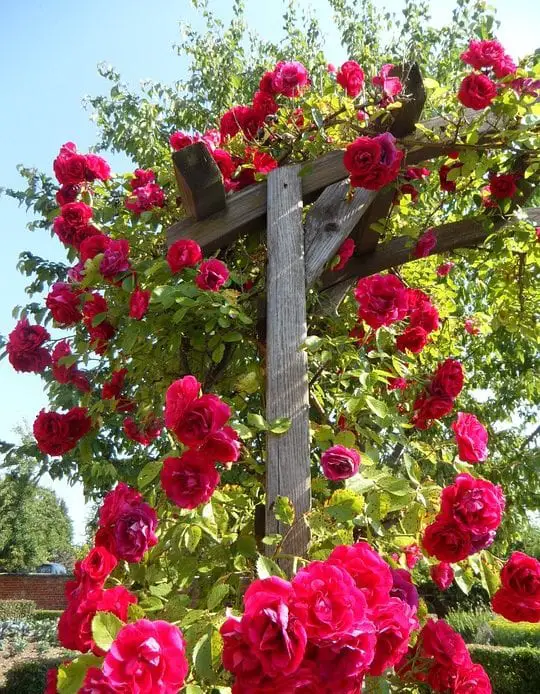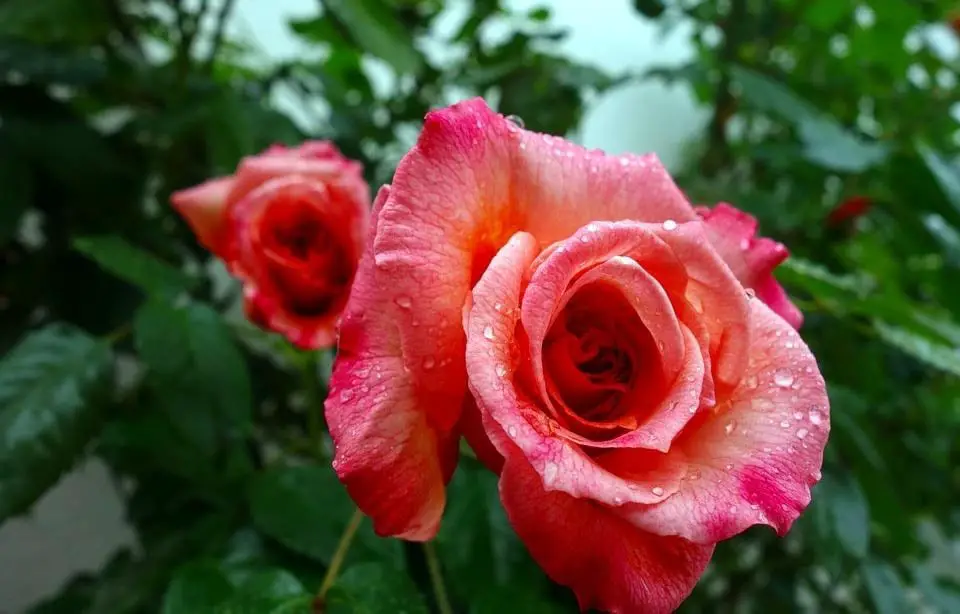
The Peace rose is formally known as Rosa “Madame A. Meilland”. It is a very well-known garden rose. These plants have large flowers that vary in shade from cream to light yellow. The edges of these petals are slightly flushed with crimson pink.
The climbing Peace rose is a hardy plant that is resistant to all sorts of plant diseases. This is what makes it extremely popular as a garden plant as well as in the floral trade. The French horticulturist developed the plant, Francis Meilland between the years 1935 to 1939, before the German invasion. This rose is a hybrid tea rose. The blooms are typically larger than most of the other garden roses, and they grow up to at least 6 feet (1.83 m) tall with a base spread of 4 feet (1.22 m).
The climbing peace roses are vigorous growing bushes with long trailing stems that make it an ideal plant for covering a bare wall or fence. It is a very versatile plant – it can be used as a garden rose or a cut rose. It can be used either solitarily or in groups, as a standard rose or as a potted plant.
How to care for a Climbing Peace Rose
1. Understand the plant: a climbing peace rose plant typically has two types of canes – the main cane and a lateral cane. The main cane forms the structure of the plant, while the lateral cane produces the blooms. The trick to growing a successful climbing peace rose plant is to plant your main cane horizontally. This ensures that the lateral canes grow vertically, giving rise to conspicuous and successful blooms.
2. Since these plants use supports in order to grow, or “climb”, use suitable support in an adequate area to plant your peace roses. For example, a sturdy bamboo cane mounted well into the ground is suitable to support.
3. The climbing peace rose is typically a sun-loving plant. Orient your plant in the direction that receives the most sunlight during the day, ensuring that it gets a partial shade as well.
4. Make sure to plant each climbing peace rose approximately 2 m away from each other, and as close to the support as possible. Ensure that they are trained in the desired direction.
5. The best time to plant a climbing peace rose plant in temperate countries is during the months of May and June. A rose bought in a container pot, however, can also be planted in the summer.
6. To ensure that the climbing peace rose has established itself successfully, do not prune the bushes for the first few years.
7. A hole should be dug in between the two supports. The approximate dimensions of this hole are to be around 60 cm x 60 cm, and it should be bigger than the sapling. This ensures that the roots have more than enough space to spread outwards without them having to curl or fold over.
8. Fill the hole with adequate water, especially if you are planting your peace rose in the summer. The hole must also be filled with mulch and rich soil substance.
9. Plant your sapling into the hole, taking good care to leave the root system intact. The white roots are alive, and need to be left intact. The brown roots, however, are dead and need to be removed carefully.
10. While planting your climbing peace rose, make sure the roots are planted 2-3 fingers deep into the soil.
11. Make sure the hole has good airflow. This is extremely important in determining the health of your climbing peace rose.
12. Once the sapling is planted firmly, cover the area around the plant base in the hole with a more soil-rich substance. This to avoid any pores. Soak the soil well. Watering the soil while planting your climbing peace rose ensures that the soil has set around the roots properly.

Caring for climbing peace roses after planting
1. Climbing peace roses need to be watered every 7-10 days with one bucket of water. Water stagnation should be avoided as well as possible, as it is undesirable for the rose root system.
2. Climbing peace roses bloom best when they receive additional plant food. It is best to start providing the plants with these additional foods after the second year. You can use liquid dissolved organic plant food, compost, or complex mineral plant food. The plants are to be fed 3 times per season. The first should be in early spring when the foliage begins to develop. The second time should be during the first big bloom cycle. The third time should be some time during mid-July.
3. Make sure you take the time to give your climbing peace rose. A generous layer of mulch around the base. The mulch retains moisture and cools the surface of the soil. It also provides a suitable barrier between the rose’s foliage and the area of the soil in which pests and disease agents live.
How to prune a climbing peace rose?
Proper pruning of the climbing peace rose is an essential part of the gardening process.
1. Cut off diseased or dead branches. As mentioned above, pruning should be done after the first few years to make sure the rose has established itself properly.
2. During winter, the top-most flowers often get frozen if the temperatures dip too much. In this case, before the temperature drops below 0 degrees, the branch should be bent towards the ground and promptly pinned in place.
3. It is then often covered with a synthetic material to protect it from the cold. When the temperatures stabilize and go back above 0 degrees, the branches are pinned back to their original supports.
The Climbing Peace Rose has won many awards that highlight its popularity – it won the award for “Most beautiful French Rose” in Lyon in 1942. It makes for an excellent ornamental garden plant as it produces beautiful, fragrant flowers that are quite easy to care for if the guidelines mentioned above are followed carefully!
